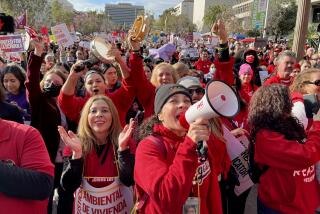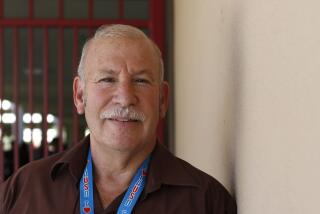L.A. school board’s us-versus-them dynamic doesn’t help students
If you plan to attend the Los Angeles school board meeting today, you might want to pack a lunch. And a dinner. And maybe even a pillow.
If the last two meetings are any measure, we’re heading back to the bad old days of L.A. Unified, when battling board members and complex issues routinely produced sessions so long that parents had to leave to put the kids to bed before their turn to speak rolled around.
I didn’t attend last week’s meeting, but I watched the replay Sunday on television. It lasted longer than two football games. Who won and who lost was hard to tell.
The eight-hour session dealt with two big issues: What to do about the beleaguered iPad project, and whom to favor in passing out federal funds earmarked for low-income kids.
By the end of the night, both were resolved in ways that seemed to please no one — in a district that can’t seem to avoid the dynamic of framing issues as “us against them.”
Board member Steve Zimmer put it bluntly: “I’m nervous about the tone and tenor in the room,” he said during the contentious discussion of how to spend federal anti-poverty money. “These questions go way beyond applauding for one side or the other.”
As he spoke, I heard applause from the crowd in the auditorium.
::
For years, Los Angeles campuses with at least 40% low-income students got federal money to pay for services — additional teachers, tutoring, counseling, parent education — to help close the achievement gap between poor and middle-income students.
But the district changed its formula two years ago to give more of that federal money to schools with the most low-income children. Now 50% of a school’s students must be poor for the campus to receive that extra funding.
Last Tuesday the board was asked by its San Fernando Valley members to reconsider the change because it’s hurting suburban schools with large groups of low-income students.
Without a change, Chatsworth High, where 49% of the students are low-income, will have to cut half a million dollars from next year’s budget, after losing $235,000 this year. Tiny Dahlia Heights Elementary, near Eagle Rock, will lose after-school computer sessions, homework help, library hours, math intervention, an art program — all because it’s a few poor students shy of this year’s 50% threshold.
West Valley board member Tamar Galatzan sees the shift as a blow to schools and struggling families, bobbing just above the poverty line.
“These aren’t the kind of schools that can raise that money from their parents,” she said. Most are in working-class neighborhoods. Many are seeing test scores slide. Some are considering leaving the district and going charter to maximize their shrunken budgets.
Let them go, said board member Monica Garcia, whose Eastside schools are packed with low-income students from low-income neighborhoods.
Restoring the money to Galatzan’s schools “means taking books away from poor children.” she said.
But the choice is not just about books or field trips or homework help; it’s also a philosophical decision about which poor kids matter most in a district that can’t call on much of a middle class.
Going back to the previous formula would take about $5 away from each of the hundreds of thousands of low-income students in poverty-heavy neighborhoods like Garcia’s.
And it would produce about $300 for each low-income student at schools where poverty hovers between 40% and under 50%.
“Today,” board member Garcia declared, “we are choosing one over the other.”
The audience booed when she said that — to their credit, I thought.
::
Two weeks ago, The Times lauded school board members for displaying “conspicuous courtesy” in a previous meeting, and putting aside their personal divisions.
But those divisions go deeper than personality, and explain why the district feels as if it’s splintering and why the debate over federal funds became so acrimonious.
“Every debate is magnified now,” said Galatzan, whose motion to return to the 40% threshold lost because the board deadlocked.
“It wasn’t like this 10 years ago,” she said. “But everything’s been cut to the bone for most schools; this was the only money they could hang on to.”
She understands Garcia’s desire to protect high-poverty schools. The parents weren’t so forgiving.
“I would hope that this board could see past the division and the sort of factionalism I saw that day,” said Rachel Greene, whose children attend a school that stands to lose $144,000 next year. “A child in need is a child in need, whatever school she attends.”
It hurt, she said, to hear Garcia lecture them from the board room dais, “saying we don’t understand poverty.”
“They barely bothered to listen when our children went up to the microphone to talk about what that money means to them,” she said. “It was disheartening.”
Galatzan couldn’t offer much comfort from her spot on the losing end. “The funding is going to get better,” she said. “We might not stress so much. But there are real philosophical differences between us, and I don’t see that going away. That will be the struggle.”
Twitter: @SandyBanksLAT
More to Read
Start your day right
Sign up for Essential California for news, features and recommendations from the L.A. Times and beyond in your inbox six days a week.
You may occasionally receive promotional content from the Los Angeles Times.







